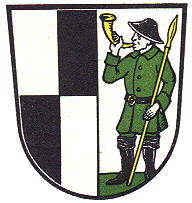Baiersdorf: Difference between revisions
Knorrepoes (talk | contribs) m (Text replacement - "{{media}}" to " {{de1}} {{media1}}") |
Knorrepoes (talk | contribs) m (Text replacement - "{{de}}" to "") |
||
| Line 1: | Line 1: | ||
'''BAIERSDORF''' | '''BAIERSDORF''' | ||
Revision as of 14:53, 26 December 2022
BAIERSDORF
State : Bayern
District (Kreis) : Erlangen-Höchstadt (until 1973 Erlangen)
Additions : 1971 Wellerstadt; 1978 Hagenau und, Igelsdorf
| German |
Gespalten; vorne geviert von Silber und Schwarz; hinten auf grünem Boden stehend ein grün gekleideter Geleitsmann mit schwarzem Gürtel, Hut und schwarzen Stiefeln, der in ein goldenes Horn bläst und in der Linken einen goldenen Spieß hält. |
| English | No blazon/translation known. Please click here to send your (heraldic !) blazon or translation |
Origin/meaning
Baiersdorf received city rights before 1353, but the oldest seal is known from 1458. The seal already showed the above arms. The arms show in the left half a man, officially described as a Geleitsmann (guide ?). The right half shows the quartered shield of the Hohenzollern family, Viscounts of Nürnberg, who ruled the city for many centuries. During the centuries the man has often been misinterpreted and was sometimes shown as a savage, postman, guard, shepherd or hunter.
| The arms on a municipal stamp (1892) |
The arms by Hupp in the Kaffee Hag albums +/- 1925 |
Literature: Stadler, 1964-1971, 8 volumes.


